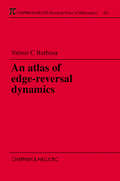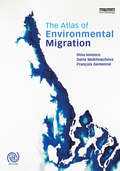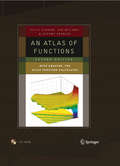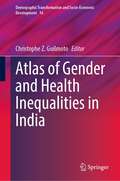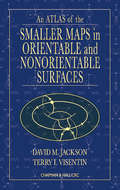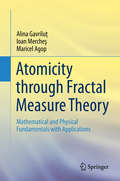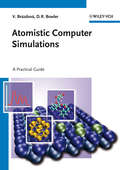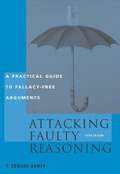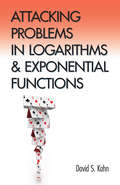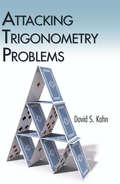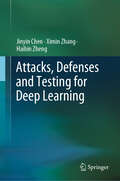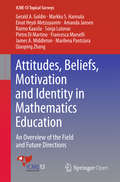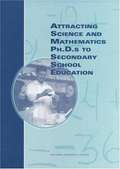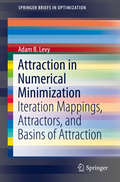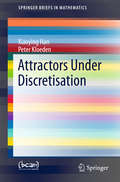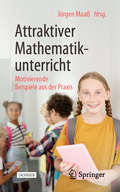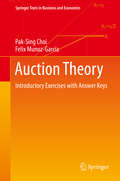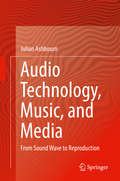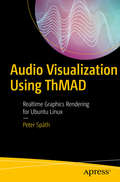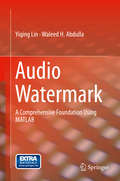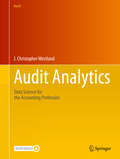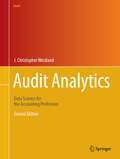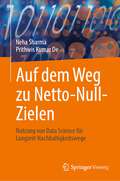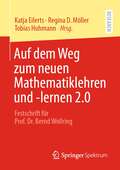- Table View
- List View
An Atlas of Edge-Reversal Dynamics (Chapman & Hall/CRC Research Notes in Mathematics Series)
by V.C. BarbosaThis important resource offers the first in-depth account of the graph dynamics system SER (Scheduling by Edge Reversal),. In Part 1: Edge-Reversal Dynamics, the author discusses the main applications and properties of SER, provides data from statistics and correlations computed over several graph classes, and gives an overview of the algorithmic aspects of the construction of the catalogue. Part 2: The Atlas comprises the atlas proper-a catalogue of graphical representations of all basins of attraction generated by the SER mechanism for all graphs in selected classes.
The Atlas of Environmental Migration
by Dina Ionesco Daria Mokhnacheva François GemenneAs climate change and extreme weather events increasingly threaten traditional landscapes and livelihoods of entire communities the need to study its impact on human migration and population displacement has never been greater. The Atlas of Environmental Migration is the first illustrated publication mapping this complex phenomenon. It clarifies terminology and concepts, draws a typology of migration related to environment and climate change, describes the multiple factors at play, explains the challenges, and highlights the opportunities related to this phenomenon. Through elaborate maps, diagrams, illustrations, case studies from all over the world based on the most updated international research findings, the Atlas guides the reader from the roots of environmental migration through to governance. In addition to the primary audience of students and scholars of environment studies, climate change, geography and migration it will also be of interest to researchers and students in politics, economics and international relations departments.
An Atlas of Functions: with Equator, the Atlas Function Calculator
by Keith B. Oldham Jerome Spanier Jan MylandThis second edition of An Atlas of Functions, with Equator, the Atlas Function Calculator, provides comprehensive information on several hundred functions or function families, of interest to all those scientists, engineers and mathematicians who are concerned with the quantitative aspects of their field. Beginning with simple integer-valued functions, the book progresses to polynomials, exponential, trigonometric, Bessel, and hypergeometric functions, as well as many more. The 65 chapters are arranged roughly in order of increasing complexity, mathematical sophistication being kept to a minimum while utility is stressed throughout. In addition to providing definitions and simple properties for every function, each chapter catalogs more complex interrelationships as well as the derivatives, integrals, Laplace transforms and other characteristics of the function. Numerous color figures in 2 or 3 dimensions depict their shape and qualitative features and flesh out the reader's familiarity with the functions. In many instances, the chapter concludes with a concise exposition on a topic in applied mathematics associated with the particular function or function family. Features that make the Atlas an invaluable reference tool, yet simple to use, include: full coverage of those functions--elementary and "special"--that meet everyday needsa standardized chapter format, making it easy to locate needed information on such aspects as: nomenclature, general behavior, definitions, intrarelationships, expansions, approximations, limits, and response to operations of the calculusextensive cross-referencing and comprehensive indexing, with useful appendicesthe inclusion of innovative software--Equator, the Atlas Function Calculatorthe inclusion of new material dealing with interesting applications of many of the function families, building upon the favorable responses to similar material in the first edition.
Atlas of Gender and Health Inequalities in India (Demographic Transformation and Socio-Economic Development #16)
by Christophe Z. GuilmotoHow will the world's largest population approach its inequality challenges? This volume addresses this question by unraveling different strands of India's emerging health and gender geographies. It is the first book to offer a comparative study of these disparities in India, stressing the deep interaction between health challenges and patriarchal features. Most themes explored in this book illustrate the entangled nature of the social and regional determinants of gender and health imbalances in India. Through its rich cartography of contemporary India, the book represents the first Atlas exploiting district-level figures drawn from the latest sociodemographic survey conducted in 2019-21. After an initial methodological synopsis, the book is built around twenty chapters—illustrated by 75 original maps, figures, and tables prepared by thirty authors—and concludes with a synthesis of India's spatial patterns. Chapters engage with major themes of gender and health inequalities and explore an array of innovative indicators such as access to menstrual hygiene, cesarean deliveries, health insurance, son preference in fertility, female landownership, patrilocal systems, hypertension, anemia, hysterectomy, girl-only or single-child families, or traditional contraception. Together, they provide an often surprising glimpse into the present and future of India's gender and health landscape, highlighting the considerable progress accomplished over the last two decades alongside persistent gaps and emerging issues.
An Atlas of the Smaller Maps in Orientable and Nonorientable Surfaces (Discrete Mathematics and Its Applications)
by David Jackson Terry I. VisentinMaps are beguilingly simple structures with deep and ubiquitous properties. They arise in an essential way in many areas of mathematics and mathematical physics, but require considerable time and computational effort to generate. Few collected drawings are available for reference, and little has been written, in book form, about their enumerative a
Atomicity through Fractal Measure Theory: Mathematical and Physical Fundamentals with Applications
by Alina Gavriluţ Ioan Mercheş Maricel AgopThis book presents an exhaustive study of atomicity from a mathematics perspective in the framework of multi-valued non-additive measure theory. Applications to quantum physics and, more generally, to the fractal theory of the motion, are highlighted. The study details the atomicity problem through key concepts, such as the atom/pseudoatom, atomic/nonatomic measures, and different types of non-additive set-valued multifunctions. Additionally, applications of these concepts are brought to light in the study of the dynamics of complex systems.The first chapter prepares the basics for the next chapters. In the last chapter, applications of atomicity in quantum physics are developed and new concepts, such as the fractal atom are introduced. The mathematical perspective is presented first and the discussion moves on to connect measure theory and quantum physics through quantum measure theory. New avenues of research, such as fractal/multifractal measure theory with potential applications in life sciences, are opened.
Atomistic Computer Simulations: A Practical Guide
by Veronika Brazdova David R. BowlerMany books explain the theory of atomistic computer simulations; this book teaches you how to run themThis introductory "how to" title enables readers to understand, plan, run, and analyze their own independent atomistic simulations, and decide which method to use and which questions to ask in their research project. It is written in a clear and precise language, focusing on a thorough understanding of the concepts behind the equations and how these are used in the simulations. As a result, readers will learn how to design the computational model and which parameters of the simulations are essential, as well as being able to assess whether the results are correct, find and correct errors, and extract the relevant information from the results. Finally, they will know which information needs to be included in their publications.This book includes checklists for planning projects, analyzing output files, and for troubleshooting, as well as pseudo keywords and case studies.The authors provide an accompanying blog for the book with worked examples, and additional material and references: http://www.atomisticsimulations.org/.
Attacking Probability and Statistics Problems
by David S. KahnConcise and highly focused, this volume offers everything high school and beginning college students need to know to handle problems in probability and statistics. Numerous rigorously tested examples and coherent, to-the-point explanations are presented in an easy-to-follow format.The treatment is organized in a way that permits readers to advance sequentially or skip around between chapters. An essential companion volume to the author's Attacking Trigonometry Problems and Attacking Problems in Logarithms and Exponential Functions, this book will equip students with the skills they will need to successfully approach the problems in probability and statistics that they will encounter on exams.
Attacking Problems in Logarithms and Exponential Functions (Dover Books on Mathematics)
by David S. KahnThis original volume offers a concise, highly focused review of what high school and beginning college students need to know in order to solve problems in logarithms and exponential functions. Numerous rigorously tested examples and coherent to-the-point explanations, presented in an easy-to-follow format, provide valuable tools for conquering this challenging subject. The treatment is organized in a way that permits readers to advance sequentially or skip around between chapters. An essential companion volume to the author's Attacking Trigonometry Problems, this book will equip students with the skills they will need to successfully approach the problems in logarithms and exponential functions that they will encounter on exams.
Attacking Trigonometry Problems (Dover Books on Mathematics)
by David S. KahnThis volume offers a concise, highly focused review of what high school and beginning college undergraduates need to know to successfully solve the trigonometry problems they will encounter on exams. Rigorously tested examples and coherent, to-the-point explanations are presented in an accessible form and will provide valuable assistance in conquering this challenging subject.Rather than serving as a text or treatise, the book focuses on the essentials of trigonometry. All fourteen sections are organized in a manner that allows readers to advance sequentially or to skip around. The approach encourages memorization of ratios and formulas, and the practice problems offer ample opportunities to become comfortable with applying the trig ratios to a variety of settings.
Attacks, Defenses and Testing for Deep Learning
by Jinyin Chen Ximin Zhang Haibin ZhengThis book provides a systematic study on the security of deep learning. With its powerful learning ability, deep learning is widely used in CV, FL, GNN, RL, and other scenarios. However, during the process of application, researchers have revealed that deep learning is vulnerable to malicious attacks, which will lead to unpredictable consequences. Take autonomous driving as an example, there were more than 12 serious autonomous driving accidents in the world in 2018, including Uber, Tesla and other high technological enterprises. Drawing on the reviewed literature, we need to discover vulnerabilities in deep learning through attacks, reinforce its defense, and test model performance to ensure its robustness. Attacks can be divided into adversarial attacks and poisoning attacks. Adversarial attacks occur during the model testing phase, where the attacker obtains adversarial examples by adding small perturbations. Poisoning attacks occur during the model training phase, wherethe attacker injects poisoned examples into the training dataset, embedding a backdoor trigger in the trained deep learning model. An effective defense method is an important guarantee for the application of deep learning. The existing defense methods are divided into three types, including the data modification defense method, model modification defense method, and network add-on method. The data modification defense method performs adversarial defense by fine-tuning the input data. The model modification defense method adjusts the model framework to achieve the effect of defending against attacks. The network add-on method prevents the adversarial examples by training the adversarial example detector. Testing deep neural networks is an effective method to measure the security and robustness of deep learning models. Through test evaluation, security vulnerabilities and weaknesses in deep neural networks can be identified. By identifying and fixing these vulnerabilities, the security and robustness of the model can be improved. Our audience includes researchers in the field of deep learning security, as well as software development engineers specializing in deep learning.
Attitudes, Beliefs, Motivation and Identity in Mathematics Education: An Overview of the Field and Future Directions (ICME-13 Topical Surveys)
by Markku S. Hannula Pietro Di Martino Marilena Pantziara Qiaoping Zhang Francesca Morselli Einat Heyd-Metzuyanim Sonja Lutovac Raimo Kaasila James A. Middleton Amanda Jansen Gerald A GoldinThis book records the state of the art in research on mathematics-related affect. It discusses the concepts and theories of mathematics-related affect along the lines of three dimensions. The first dimension identifies three broad categories of affect: motivation, emotions, and beliefs. The book contains one chapter on motivation, including discussions on how emotions and beliefs relate to motivation. There are two chapters that focus on beliefs and a chapter on attitude which cross-cuts through all these categories. The second dimension covers a rapidly fluctuating state to a more stable trait. All chapters in the book focus on trait-type affect and the chapter on motivation discusses both these dimensions. The third dimension regards the three main levels of theorizing: physiological (embodied), psychological (individual) and social. All chapters reflect that mathematics-related affect has mainly been studied using psychological theories.
Attracting Science And Mathematics Ph.d.s To Secondary School Education
by National Research CouncilThe National Research Council conducted a study to identify a set of incentives that state governments and local school districts can use to attract Ph.D. scientists and mathematicians to secondary school teaching positions. This project investigated the career ambitions of Ph.D.s in the physical and life sciences through focus groups and a national survey to determine the kinds of work conditions and compensation packages that would induce them to take positions teaching physics, chemistry, biology, and various electives in public high schools or positions developing secondary school science and mathematics curricula. The study conducted interviews with Ph.D.s who are already teaching in secondary schools to ascertain information from their experiences, with local school district administrators to assess what they are realistically willing to offer Ph.D. scientists to attract them, and with higher education administrators to explore programmatic changes they would need to institute to provide Ph.D.s with skills tailored to secondary school teaching. These investigations led to this report which describes the incentives local school districts could use in establishing pilot programs in this area.
Attraction in Numerical Minimization: Iteration Mappings, Attractors, and Basins of Attraction (SpringerBriefs in Optimization)
by Adam B. LevyNumerical minimization of an objective function is analyzed in this book to understand solution algorithms for optimization problems. Multiset-mappings are introduced to engineer numerical minimization as a repeated application of an iteration mapping. Ideas from numerical variational analysis are extended to define and explore notions of continuity and differentiability of multiset-mappings, and prove a fixed-point theorem for iteration mappings. Concepts from dynamical systems are utilized to develop notions of basin size and basin entropy. Simulations to estimate basins of attraction, to measure and classify basin size, and to compute basin are included to shed new light on convergence behavior in numerical minimization. Graduate students, researchers, and practitioners in optimization and mathematics who work theoretically to develop solution algorithms will find this book a useful resource.
Attractors Under Discretisation (SpringerBriefs in Mathematics)
by Peter Kloeden Xiaoying HanThis work focuses on the preservation of attractors and saddle points of ordinary differential equations under discretisation. In the 1980s, key results for autonomous ordinary differential equations were obtained - by Beyn for saddle points and by Kloeden & Lorenz for attractors. One-step numerical schemes with a constant step size were considered, so the resulting discrete time dynamical system was also autonomous. One of the aims of this book is to present new findings on the discretisation of dissipative nonautonomous dynamical systems that have been obtained in recent years, and in particular to examine the properties of nonautonomous omega limit sets and their approximations by numerical schemes - results that are also of importance for autonomous systems approximated by a numerical scheme with variable time steps, thus by a discrete time nonautonomous dynamical system.
Attraktiver Mathematikunterricht: Motivierende Beispiele aus der Praxis
by Jürgen MaaßDieses Sachbuch zeigt Wege zu einem attraktiveren Mathematikunterricht in Beispielen auf, die als Abschlussarbeiten seiner ehemaliger Studenten (und Coautoren) praxiserprobt sind. Das Buch lädt zur Reflexion der eigenen Erfahrungen mit Mathematikunterricht und einer Diskussion darüber ein. Farbige Kästen fordern zur aktiven Teilnahme oder Weiterführung der Projekte auf.
Auction Theory: Introductory Exercises with Answer Keys (Springer Texts in Business and Economics)
by Felix Munoz-Garcia Pak-Sing ChoiThis textbook provides a short introduction to auction theory through exercises with detailed answer keys. Focusing on practical examples, this textbook offers over 80 exercises that predict bidders’ equilibrium behaviour in different auction formats, along with the seller’s strategic incentives to organize one auction format over the other. The book emphasizes game-theoretic tools, so students can apply similar tools to other auction formats. Also included are several exercises based on published articles, with the model reduced to its main elements and the question divided into several easy-to-answer parts. Little mathematical background in algebra and calculus is assumed, and most algebraic steps and simplifications are provided, making the text ideal for upper undergraduate and graduate students.The book begins with a discussion of second-price auctions, which can be studied without using calculus, and works through progressively more complicated auction scenarios: first-price auctions, all-pay auctions, third-price auctions, the Revenue Equivalence principle, common-value auctions, multi-unit auctions, and procurement auctions. Exercises in each chapter are ranked according to their difficulty, with a letter (A-C) next to the exercise title, which allows students to pace their studies accordingly. The authors also offer a list of suggested exercises for each chapter, for instructors teaching at varying levels: undergraduate, Masters, Ph.D.Providing a practical, customizable approach to auction theory, this textbook is appropriate for students of economics, finance, and business administration. This book may also be used for related classes such as game theory, market design, economics of information, contract theory, or topics in microeconomics.
Audio Technology, Music, and Media: From Sound Wave to Reproduction
by Julian AshbournThis book provides a true A to Z of recorded sound, from its inception to the present day, outlining how technologies, techniques, and social attitudes have changed things, noting what is good and what is less good. The author starts by discussing the physics of sound generation and propagation. He then moves on to outline the history of recorded sound and early techniques and technologies, such as the rise of multi-channel tape recorders and their impact on recorded sound. He goes on to debate live sound versus recorded sound and why there is a difference, particularly with classical music. Other topics covered are the sound of real instruments and how that sound is produced and how to record it; microphone techniques and true stereo sound; digital workstations, sampling, and digital media; and music reproduction in the home and how it has changed. The author wraps up the book by discussing where we should be headed for both popular and classical music recording and reproduction, the role of the Audio Engineer in the 21st century, and a brief look at technology today and where it is headed. This book is ideal for anyone interested in recorded sound. “[Julian Ashbourn] strives for perfection and reaches it through his recordings… His deep knowledge of both technology and music is extensive and it is with great pleasure that I see he is passing this on for the benefit of others. I have no doubt that this book will be highly valued by many in the music industry, as it will be by me.” -- Claudio Di Meo, Composer, Pianist and Principal Conductor of The Kensington Philharmonic Orchestra, The Hemel Symphony Orchestra and The Lumina Choir
Audio Visualization Using ThMAD
by Peter SpäthLearn how to use Thinking Machine Audio Dreams (ThMAD), a realtime audio visualization engine for Ubuntu Linux. This book bridges the gap between programmers and artists. Both artists and developers with an inclination towards arts will profit from this book since it is a combination of a hands-on tutorial, manual, and reference, with many illustrations that accompany the explanations and tutorials.You'll learn the basics of ThMAD's open source software suite and then start experimenting and building your own rendering pipelines to create audio visualizations. You'll see how to soundly use all ThMAD's GUI functionalities, and all modules are provided in a way that will serve both intellectual curiosity and professional needs. The examples that are used as part of the software, and the tutorials included in the book, will serve as a solid basis for your own experiments.What You'll LearnUse the ThMAD software, all GUI functionalities, and all modulesDevelop your own audio visualization projectsExplore the program operations for ThMAD Artiste and ThMAD Player, including all possible options for controlling program operations.Who This Book Is ForVisual artists with some IT background, or developers with artistic inclinations. Development experience is not required, but surely helpful.
Audio Watermark: A Comprehensive Foundation Using MATLAB
by Yiqing Lin Waleed H. AbdullaThis book illustrates the commonly used and novel approaches of audio watermarking for copyrights protection. The author examines the theoretical and practical step by step guide to the topic of data hiding in audio signal such as music, speech, broadcast. The book covers new techniques developed by the authors are fully explained and MATLAB programs, for audio watermarking and audio quality assessments and also discusses methods for objectively predicting the perceptual quality of the watermarked audio signals. Explains the theoretical basics of the commonly used audio watermarking techniques Discusses the methods used to objectively and subjectively assess the quality of the audio signals Provides a comprehensive well tested MATLAB programs that can be used efficiently to watermark any audio media
Audit Analytics: Data Science for the Accounting Profession (Use R!)
by J. Christopher WestlandToday, information technology plays a pivotal role in financial control and audit: most financial data is now digitally recorded and dispersed among servers, clouds and networks over which the audited firm has no control. Additionally, a firm’s data—particularly in the case of finance, software, insurance and biotech firms— comprises most of the audited value of the firm. Financial audits are critical mechanisms for ensuring the integrity of information systems and the reporting of organizational finances. They help avoid the abuses that led to passage of legislation such as the Foreign Corrupt Practices Act (1977), and the Sarbanes-Oxley Act (2002). Audit effectiveness has declined over the past two decades as auditor skillsets have failed to keep up with advances in information technology. Information and communication technology lie at the core of commerce today and are integrated in business processes around the world. This book is designed to meet the increasing need of audit professionals to understand information technology and the controls required to manage it. The material included focuses on the requirements for annual Securities and Exchange Commission audits (10-K) for listed corporations. These represent the benchmark auditing procedures for specialized audits, such as internal, governmental, and attestation audits.Using R and RStudio, the book demonstrates how to render an audit opinion that is legally and statistically defensible; analyze, extract, and manipulate accounting data; build a risk assessment matrix to inform the conduct of a cost-effective audit program; and more.
Audit Analytics: Data Science for the Accounting Profession (Use R!)
by J. Christopher WestlandThis book, using R and RStudio, demonstrates how to render an audit opinion that is legally and statistically defensible; analyze, extract, and manipulate accounting data; build a risk assessment matrix to inform the conduct of a cost-effective audit program; and more. Today, information technology plays a pivotal role in financial control and audit: most financial data is now digitally recorded and dispersed among servers, clouds and networks over which the audited firm has no control. Additionally, a firm’s data—particularly in the case of finance, software, insurance and biotech firms—comprises most of the audited value of the firm. Financial audits are critical mechanisms for ensuring the integrity of information systems and the reporting of organizational finances. They help avoid the abuses that led to passage of legislation such as the Foreign Corrupt Practices Act (1977), and the Sarbanes-Oxley Act (2002). Audit effectiveness has declined over the past two decades, as auditor skillsets have failed to keep up with advances in information technology. Information and communication technology lie at the core of commerce today and are integrated in business processes around the world. This book is designed to meet the increasing need of audit professionals to understand information technology and the controls required to manage it. This 2nd edition includes updated code and test. Machine learning, AI, and SEC’s EDGAR data are also, improved and updated. The material included focuses on the requirements for annual Securities and Exchange Commission audits (10-K) for listed corporations. These represent the benchmark auditing procedures for specialized audits, such as internal, governmental, and attestation audits. Many examples reflect the focus of the 2024 CPA exam, and the data analytics-machine learning approach will be central to the AICPA’s programs, in the near future.
Auf dem Weg zu Netto-Null-Zielen: Nutzung von Data Science für Langzeit-Nachhaltigkeitswege
by Neha Sharma Prithwis Kumar DeDieses Buch diskutiert die Verwendung von Technologie, Data Science und Open Data, um das Netto-Null-Emissionsziel des Pariser Abkommens zum Klimawandel zu erreichen. Es gibt viele Diskussionen über Nachhaltigkeit und Lösungen für den Klimawandel, um die negativen Auswirkungen zu mildern. Die Verwendung von Technologiehebeln zur Bewältigung von Klimaherausforderungen wird jedoch selten als der bedeutendste Katalysator betrachtet. Die verfügbare Forschung in diesem Bereich ist im Allgemeinen qualitativer Natur, bei der Technologie und Daten noch nicht genutzt wurden. Durch den Einsatz von KI/ML sagt das Buch die Klimawandelfolgen aufgrund von Investitionen in den fossilen Brennstoffsektor voraus, schätzt die CO2-Emissionen des Verkehrssektors, prognostiziert die durch nicht erneuerbare Energiequellen verursachte durchschnittliche Landtemperatur und segmentiert indische Bundesstaaten auf der Grundlage von Haushalts-CO2-Emissionen. Die Forscher, Entscheidungsträger, Studenten, Lehrer, Bildungseinrichtungen, Regierungen, Regulierungsbehörden, Unternehmen, internationale Organisationen usw. werden immens von diesem Buch profitieren. Darüber hinaus soll dieses Buch dazu dienen, den nächsten Generationen eine dekarbonisierte Umgebung und eine bessere Zukunft zu bieten.
Auf dem Weg zum neuen Mathematiklehren und -lernen 2.0: Festschrift für Prof. Dr. Bernd Wollring
by Regina Möller Katja Eilerts Tobias HuhmannDie vorliegende Schrift widmen wir unserem langjährigen und geschätzten Kollegen Bernd Wollring anlässlich seines 70. Geburtstages. Wir sehen diesen Geburtstag als willkommenen Anlass, sein Lebenswerk umfassend zu würdigen. Seinem persönlichen Wunsch folgend steht im Fokus des Festkolloquiums die Zukunft des Mathematikunterrichts und damit eng verbunden der Lehreraus- und -fortbildung. Ein glücklicher Umstand ist die Tatsache, dass dieser Fokus mit dem 100-jährigen Bestehen der Grundschule zusammenfällt. Der Festband wurde mit großer Freude und viel Elan zusammengestellt und folgt seinem Wunsch, zum Kolloquium einen Blick in die Zukunft zu wagen. Rückwärts gewandt lässt sich ohne Mühe und sofort feststellen, welche große Spuren Bernd Wollring in den letzten Jahrzehnten in der Mathematikdidaktik hinterlassen hat. Deshalb beginnt der Band einleitend mit einem kurzen Rückblick auf sein wissenschaftliches Werk und mit einer Würdigung. Die weiteren Kapitel stehen im Zeichen von Lehren und Lernen im Mathematikunterricht und Inhaltsbereichen der Mathematikdidaktik, wobei einzelne Felder, die auch Bernd Wollring bearbeitet hat, berücksichtigt sind.
